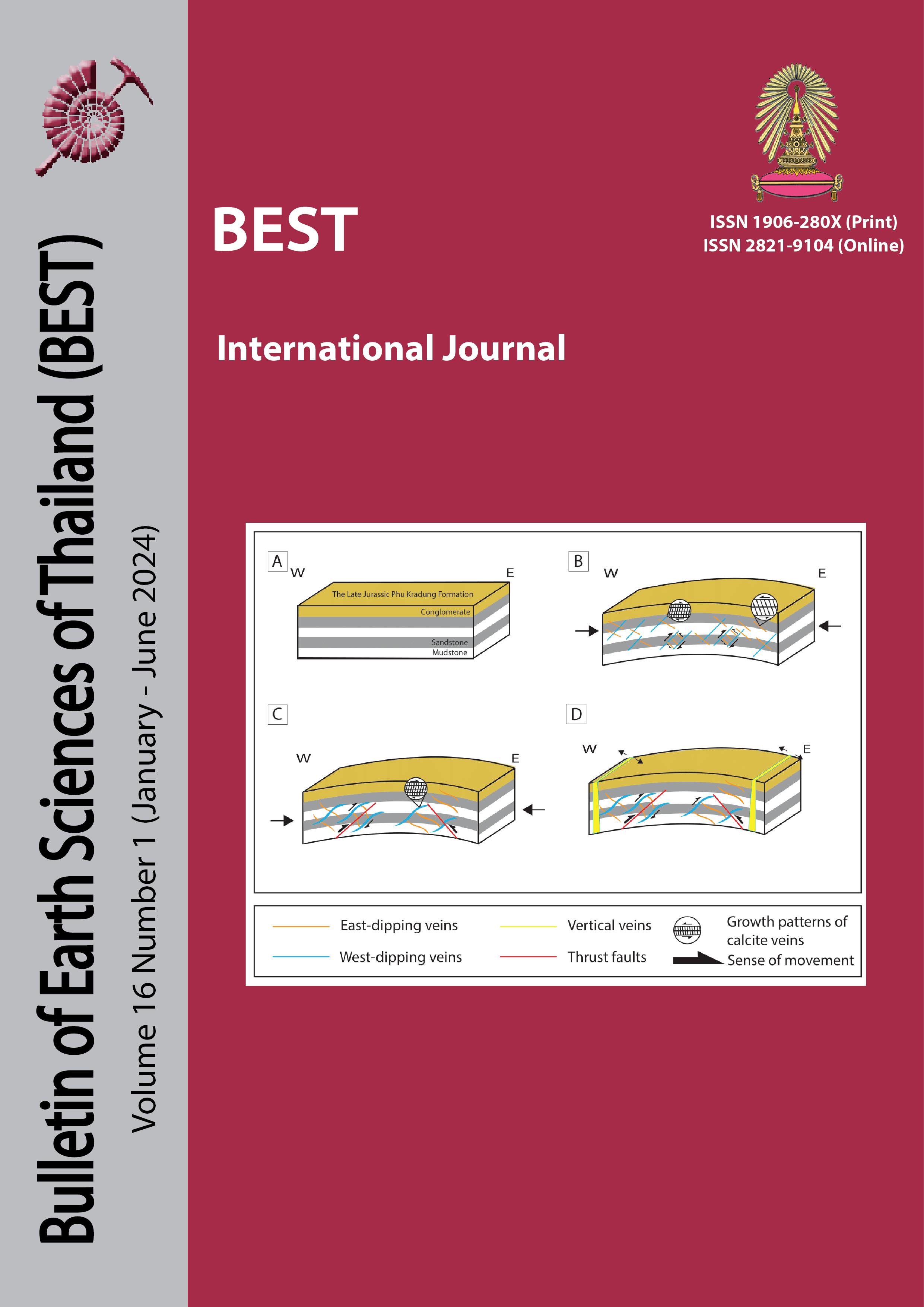The Quantifying Crustal Deformation Caused by the Cianjur Tectonic Earthquakes Magnitude 5.6 through InSAR and GNSS Technology
Main Article Content
Abstract
Indonesia, an archipelagic country situated within the volatile Ring of Fire and the convergence of multiple tectonic plates, frequently experiences seismic activity. These earthquakes have led to alterations in the Earth's surface layers and even damage to the land. The Cianjur earthquake, which occurred on November 21, 2022, was a shallow crustal tectonic earthquake of the mainshock variety, followed by a series of aftershocks. The objective of this research is to conduct deformation mapping before and after the Cianjur Magnitude 5.6 earthquake. The research employs remote sensing technology, specifically interferometric synthetic aperture radar (InSAR), in conjunction with global navigation satellite system (GNSS) analysis techniques. The results have yielded valuable insights into the spatial distribution of vertical tectonic deformation through InSAR and GNSS analysis, revealing that the co-seismic deformation reached a maximum value of 5.87 cm, concentrated in the Cugenang sub-district. In contrast, GNSS station data recorded co-seismic deformation of 4.6 cm and horizontal deformation of approximately ±12 cm, directed southeastward. These findings indicate that aftershocks had a more significant impact on deformation in the Cianjur region, particularly around the Cugenang fault area. Variations in the source of the main earthquake and subsequent aftershocks substantially influenced deformation patterns and the direction of horizontal deformation.
Article Details

This work is licensed under a Creative Commons Attribution-NonCommercial-NoDerivatives 4.0 International License.
Copyright © 2008 Department of Geology, Faculty of Science, Chulalongkorn University. Parts of an article can be photocopied or reproduced without prior written permission from the author(s), but due acknowledgments should be stated or cited accordingly.
References
Anderson S Robert and Anderson P Suzanne. (2010). Geomorphology the Mechanics And Chemistry Of Landscapes. Published in the United Kingdom by Cambridge University Press, UK. ISBN 978-0-521-51978-6 (pbk.)
BMKG Badan Meterologi Klimatologi dan Geofisika Indonesia. 2022. Ulasan Ground Motion dan Respon Spektra Gempa Bumi Cianjur 21 November 2022. Bidang Seismologi Teknik Badan Meteorologi Klimatologi dan Geofisika Published 6 December 2022. [online] https://www.bmkg.go.id/berita/.
Farolfi G, et al. (2019). A procedure to use GNSS data to calibrate satellite PSI data for the study of subsidence:an example from the north-western Adriatic coast (Italy). Taylor & Francis Online. European Journal of Remote Sensing. https://doi.org/10.1080/22797254.2019.1663710.
Franklin K. R. and M. Huang. (2022). Revealing crustal deformation and strain rate in Taiwan using InSAR and GNSS,” Geophys. Res. Lett., vol. 49, no. 21, Nov. 2022, Art. https://doi.org/10.1029/2022GL101306.
Gatsios Theodoros, et al. (2020). Copernicus Sentinel-1 MT-InSAR, GNSS and Seismic Monitoring of Deformation Patterns and Trends at the Methana Volcano, Greece. MDPI Journal Apply Science 10, 6445. https://doi.org/10.3390/app10186445.
Hanif, M.; Apichontrakul, S. 2023. Vertical Ground Deformation Monitoring of the Sinabung Volcano in 2021-2022 using Sentinel-1 and DInSAR. 12th International Conference on Environmental Engineering, Science, and Management. Pattaya Thailand.
Hanif Muhammad, Apichontrakul Sarun, Razi Pakhrur. 2024. Multi-Temporal InSAR analysis for monitoring the ground deformation of Mount Sinabung. Asia-Pacific Journal of Science and Technology.
Hastaoglu, K.O. et al. (2023). Determination of periodic deformation from InSAR results using the FFT time series analysis method in Gediz Graben. Nat Hazards 117, 491–517.
Hongdong Fan, et al. (2011). Land subsidence monitoring by D-InSAR technique. Mining Science and Technology (China). 21 (2011) 869–872. by Elsevier B.V. on behalf of China University of Mining & Technology. https://10.1016/j.mstc.2011.05.030.
Janssen, V. (2007). Volcano deformation monitoring using GPS', Journal of Spatial Science, 52: 1, 41-54, https://10.1080/14498596.2007.9635099.
Jerram Dougal. (2021). Introducing Volcanology a Guide to Hot Rock. Second Edition. Dunedin Academic Press Ltd, 8 Albany Street Edinburgh London. www.dunedinacademicpress.co.uk
Kerekes Anna–Hajnalka, Szilárd Lehel Poszet, Călin Baciu. (2020). Investigating land surface deformation using InSAR and GIS techniques in Cluj–Napoca city’s most affected sector by urban sprawl (Romania). Revista De Geomorfologie. 43-59. http://10.21094/rg.2020.097.
Kusky Timothy. (2008). Volcanoes: Eruptions and Other Volcanic Hazards. An imprint of Infobase Publishing 132 West 31st Street. New York NY 10001. ISBN: 978-0-8160-6463-2.
Komac, M., Holley. et al. (2015). Coupling of GPS/GNSS and radar interferometric data for a 3D surface displacement monitoring of landslides. Journal Landslides. https://doi.org/10.1007/s10346-014-0482-0.
Liu Guanxin, et al. (2021). Penetration Depth Inversion in Hyperarid Desert From L-Band InSAR Data Based on a Coherence Scattering Model. IEEE Geoscience and Remote Sensing Letters, Vol. 18, No. 11, November 2021. https://10.1109/LGRS.2020.3011706
Natsuaki Ryo, Nagai Hiroto, Tomii Naoya and Tadono Takeo Tadono. (2018). Sensitivity and Limitation in Damage Detection for Individual Buildings Using InSAR Coherence—A Case Study in 2016 Kumamoto Earthquakes. MDPI Journal Remote Sensing. Remote Sens. https://doi.org/10.3390/rs10020245
Razi Pakhrur, JTS Sumantyo, Ming Yam Chua, Daniele Perissin, Takeo Tadono. (2023). Monitoring of tectonic deformation in the seismic gap of the Mentawai Islands using ALOS-1 and ALOS-2. Elsavier Journal Remote Sensing Applications: Society and Environment. https://doi.org/10.1016/j.rsase.2023.100973
Susilo, S., Salman, R., Hermawan, W. et al. (2023). GNSS land subsidence observations along the northern coastline of Java, Indonesia. Nature Scientific Data 10, 421. https://doi.org/10.1038/s41597-023-02274-0.
Soldato Del Matteo, Pierluigi Confuorto, Silvia Bianchini, Paolo Sbarra and Nicola Casagli, (2021). Review of Works Combining GNSS and InSAR in Europe. MDPI Journal Remote Sensing. https://doi.org/10.3390/rs13091684
Saed Galeb Farman, et al. (2022). Earthquake-Induced Ground Deformation Assessment via Sentinel-1 Radar Aided at Darbandikhan Town. Hindawi Journal of Sensors., Article ID 2020069, 11. https://doi.org/10.1155/2022/2020069.
Supendi P, Priyobudi, et al. (2022). Analisis Gempabumi Cianjur (Jawa Barat) Mw 5.6 Tanggal 21 November 2022. https://prosesweb.bmkg.go.id/wp-content/uploads/Analisis-gempabumi-Cianjur_Supendi-dkk.-2022_rev-1.pdf.


